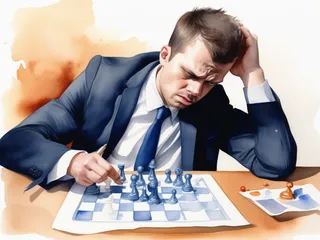I used to think strategic living was something successful people did after they'd already figured everything out — like a luxury you could afford once you had your career dialed in and your finances sorted. That's backwards thinking.
Strategic living isn't the result of having your life together. It's the operating system that helps you get your life together. It's the difference between running a well-architected system versus hoping a collection of scripts and patches will somehow work reliably in production.
The Mental Model Shift
Here's what I wish I'd understood earlier: strategic living isn't about having perfect plans or predicting the future. It's about developing better decision-making patterns that compound over time.
Think about how experienced developers approach complex problems differently than junior developers. They don't necessarily work faster or have access to better tools. They have better mental models for breaking down problems, recognizing patterns, and making decisions that create fewer complications down the road.
Strategic living works the same way. It's a meta-skill that improves how you approach everything else.
From Optimization to Architecture
Most people approach life improvement through local optimization — they try to make individual areas better without considering how the pieces fit together. This is like optimizing database queries without thinking about overall system architecture.
Strategic living is architectural thinking applied to life. You consider how decisions in one area affect other areas, how short-term choices impact long-term possibilities, and how to design systems that get better over time rather than more complicated.
The Components of Strategic Living
Intentional Direction Setting
This isn't about having a detailed life plan. It's about being intentional about the direction you're heading and regularly checking whether your daily decisions align with that direction.
I learned this lesson while working on a particularly messy codebase. The individual functions worked fine, but the overall system was brittle because no one had thought about how the pieces would interact. Each developer had optimized for their immediate needs without considering the broader architecture.
The same thing happens with life decisions. You take a job because the salary is good, then realize it doesn't provide learning opportunities. You move to a city because it's affordable, then discover it lacks the professional network you need. Each decision makes sense in isolation but creates system-level problems.
Strategic living means asking, "How does this choice fit with where I'm trying to go?" before making significant decisions.
Systems Thinking Over Event Thinking
Most people think in terms of events: "I need to get promoted," "I want to buy a house," "I should learn a new programming language." Strategic living thinks in terms of systems: "What patterns of behavior lead to career advancement?" "What capabilities and financial position would make homeownership sustainable?" "What learning approach would give me transferable skills?"
When I transitioned from purely development work to Scrum Master responsibilities, I didn't just apply for different jobs. I started building the underlying systems that would make me effective in that role: facilitating discussions, understanding team dynamics, learning about process improvement.
By the time I officially took on Scrum Master responsibilities, I had already developed relevant capabilities and built relationships that made the transition successful.
Feedback Loops and Course Correction
Strategic living requires building feedback mechanisms that help you notice when you're off course and adjust accordingly. This is like having good monitoring and alerting systems in production — they help you catch problems early when they're easier to fix.
I do quarterly reviews where I assess what's working, what isn't, and what adjustments make sense. This isn't about judging myself for decisions that didn't work out perfectly. It's about learning from the data and refining my approach.
For example, I noticed I was consistently underestimating how long it would take to build new habits. Instead of setting more modest goals, I started building more scaffolding around habit formation — environmental changes, accountability systems, and smaller incremental steps.
Strategic Living in Practice
Career Development Example
Instead of just applying for jobs when I got frustrated with my current role, I started thinking systematically about career development:
Vision: I want to work on challenging technical problems while helping teams be more effective.
System Design: I need to build both technical depth and leadership capabilities, ideally in ways that reinforce each other.
Implementation: I look for projects that combine complex technical challenges with opportunities to mentor others, facilitate discussions, or improve team processes.
Feedback Loops: I regularly check in with mentors, peers, and team members to understand how my contributions are perceived and where I can improve.
This approach led to opportunities I wouldn't have discovered through reactive job searching. People started coming to me for technical advice and process improvement ideas because I had intentionally built a reputation for both.
Learning and Skill Development
Rather than learning technologies because they're trending or seem interesting, I developed a strategic approach to skill building:
Core Capabilities: I focus on skills that transfer across different contexts — systems thinking, communication, problem-solving frameworks.
Domain Knowledge: I go deep in areas that align with my career direction and personal interests.
Exploration: I maintain a small budget of time and energy for learning things that might not have immediate applications but could create unexpected opportunities.
This prevents me from chasing every new framework while ensuring I don't get stuck with obsolete skills.
Relationship Building
Instead of networking randomly or only when I need something, I think strategically about relationship building:
Internal Networks: I invest in relationships with people across different functions and levels within my organization.
Professional Communities: I participate in communities where I can both contribute and learn from people with complementary expertise.
Mentorship: I maintain relationships with both mentors and people I mentor, creating bidirectional learning opportunities.
These relationships have led to better collaboration, more interesting project opportunities, and a stronger professional support system.
Common Misconceptions About Strategic Living
"It's Too Rigid"
Strategic living isn't about following a predetermined script. It's about having clear principles and priorities that guide decision-making while remaining adaptable to changing circumstances.
I've changed specific goals and tactics many times, but my core direction and values have remained consistent. This gives me stability without rigidity.
"It Takes Too Much Time"
The upfront investment in strategic thinking saves enormous amounts of time and energy later. When you have clear criteria for decision-making, you can evaluate opportunities quickly. When you understand your priorities, you can say no to things that don't align without agonizing over the decision.
"It's Only for Big Decisions"
Strategic thinking applies to small decisions too. The coffee shop you choose for working remotely, how you structure your learning time, which conferences you attend — these small choices compound over time.
I started applying strategic thinking to daily decisions like which projects to volunteer for, how to spend learning time, and even which social events to attend. The cumulative effect has been significant.
Building Strategic Living Habits
Start with Self-Awareness
Before you can live strategically, you need to understand your current patterns. What decisions do you make reactively? Where do you consistently struggle? What environments and activities energize versus drain you?
I spent a month tracking my decision-making patterns — not to judge them, but to understand them. This revealed blind spots and unconscious habits that were undermining my effectiveness.
Develop Decision-Making Frameworks
Create simple frameworks for evaluating choices. These don't need to be complex, just consistent ways of thinking through decisions that matter.
My basic framework involves three questions: Does this align with my core values? Does this build capabilities I want to develop? Does this create opportunities for future growth?
Practice Systems Thinking
Start looking for the systems behind outcomes you want to understand. Instead of admiring successful people, try to understand the patterns and practices that led to their success. Instead of being frustrated by problems, investigate the conditions that created them.
The Long-Term Benefits
Strategic living creates a compounding effect where good decisions build on each other over time. You develop better judgment, stronger relationships, and more capabilities. You become someone who creates opportunities rather than just responds to them.
The goal isn't to eliminate uncertainty or guarantee specific outcomes. It's to develop the capability to navigate complexity and change more effectively.
In a world where the pace of change is accelerating, strategic living becomes increasingly valuable. The specific tactics that work today might be obsolete in five years, but the ability to think strategically and adapt systematically will remain relevant.
Strategic living is ultimately about taking ownership of your life's architecture rather than letting it emerge randomly from a series of reactive decisions. It's about becoming the intentional designer of your own experience.





